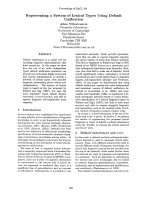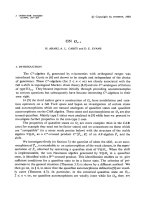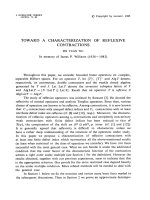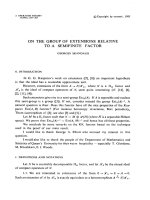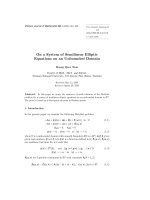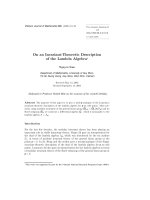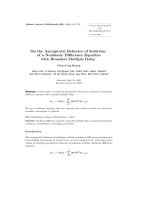Báo cáo toán học: "On a System of Semilinear Elliptic Equations on an Unbounded Domain" potx
Bạn đang xem bản rút gọn của tài liệu. Xem và tải ngay bản đầy đủ của tài liệu tại đây (117.98 KB, 9 trang )
Vietnam Journal of Mathematics 33:4 ( 2005) 381–389
On a System of Semilinear Elliptic
Equations on an Unbounded Domain
Hoang Quoc Toan
Fa culty of Math., Mech. and Inform.
Vietnam National University, 334 Nguyen Trai, Hanoi, Vietnam
Received Ma y 12, 2004
Revised August 28, 2005
Abstract. In this paper we study the existence of weak solutions of the Dirichlet
problem for a system of semilinear elliptic eq uations on an unbounded domain in
R
n
.
The proof is based on a fixed p oint theorem in Banach spaces.
1. Introduction
In the present paper we consider the following Dirichlet problem:
−Δu + q(x)u = αu + βv + f
1
(u, v)inΩ (1.1)
−Δv + q(x)v =Δu + γv + f
2
(u, v)
u|
∂Ω
=0,v|
∂Ω
=0
u(x) → 0,v(x) → 0as|x|→+∞ (1.2)
where Ω is a unbounded domain with smooth boundary ∂ΩinaR
n
, α, β, δ, γ are
given real numbers, β>0,δ>0; q(x) is a function defined in Ω,f
1
(u, v),f
2
(u, v)
are nonlinear functions for u, v such that
q(x) ∈ C
0
(R), and ∃q
0
> 0,q(x) ≥ q
0
, ∀x ∈ Ω (1.3)
q(x) → +∞ as |x|→+∞
f
i
(u, v) are Lipschitz continuous in R
n
with constants k
i
(i =1, 2)
|f
i
(u, v) − f
i
(¯u, ¯v)| k
i
(|u − ¯u| + |v − ¯v|), ∀(u, v), (¯u, ¯v) ∈ R
2
. (1.4)
382 HoangQuocToan
The aim of this paper is to study the existence of weak solution of the
problem (1.1)-(1.2) under hypothesis (1.3), (1.4) and suitable conditions for the
parameters α, β, δ, γ.
We firstly notice that the problem Dirichlet for the system (1.1) in a bounded
smooth domain have been studied by Zuluaga in [6].
Throughout the paper, (., .)and. denotes the usual scalar product and
the norm in L
2
(Ω); H
1
(Ω),
◦
H
1
(Ω) are the usual Sobolev’s spaces.
2. Preliminaries and Notations
We define in C
∞
0
(Ω) the norm (as in [1])
u
q,Ω
=
Ω
|Du|
2
+ qu
2
dx
1
2
, ∀u ∈ C
∞
0
(Ω) (2.1)
and the scalar product
a
q
(u, v)=(u, v)
q
=
Ω
(DuDv + qu.v)dx (2.2)
where Du =
∂u
∂x
1
,
∂u
∂x
2
, ··· ,
∂u
∂x
n
, ∀u, v ∈ C
∞
0
(Ω).
Then we introduce the space V
0
q
(Ω) defined as the completion of C
∞
0
(Ω) with
respect to the norm .
q,Ω
. Furthermore, the space V
0
q
(Ω) can be considered as
a Sobolev-Slobodeski’s space with weight.
Proposition 2.1. (see [1]) V
0
q
(Ω) is a Hilbert space which is dense in L
2
(Ω),
and the embedding of V
0
q
(Ω) into L
2
(Ω) is continuous and compact.
We define by the Lax-Milgram lemma a unique operator H
q
in L
2
(Ω) such
that
(H
q
u, v)=a
q
(u, v), ∀u ∈ D(H
q
), ∀v ∈ V
0
q
(Ω)
where D(H
q
)={u ∈ V
0
q
(Ω) : H
q
u =(−Δ+q)u ∈ L
2
(Ω)}.
It is obvious that the operator
H
q
: D(H
q
) ⊂ L
2
(Ω) → L
2
(Ω)
is a linear operator with range R(H
q
) ⊂ L
2
(Ω).
Since q(x) is positive, the operator H
q
is positive in the sense that:
(H
q
u, u)
L
2
(Ω)
≥ 0, ∀u ∈ D(H
q
)
and selfadjoint
(H
q
u, v)
L
2
(Ω)
=(u, H
q
v)
L
2
(Ω)
, ∀u, v ∈ D(H
q
).
Its inverse H
−1
q
is defined on R(H
q
) ∩ L
2
(Ω) with range D(H
q
), considered as
an operator into L
2
(Ω). By Proposition 2.1 it follows that H
−1
q
is a compact
System of Semilinear Elliptic Equations on an Unbounded Domain 383
operator in L
2
(Ω). Hence the spectrum of H
q
consists of a countable sequence
of eigenvalues {λ
k
}
∞
k=1
, each with finite multiplicity and the first eigenvalue λ
1
is isolated and simple:
0 <λ
1
<λ
2
··· λ
k
··· ,λ
k
→ +∞ as k → +∞.
Every eigenfunction ϕ
k
(x) associated with λ
k
(k =1, 2, ···) is continuous and
bounded on Ω and there exist positive constants α and β such that
|ϕ
k
(x)| αe
−β|x|
for |x| large enough.
Moreover eigenfunction ϕ
1
(x) > 0 in Ω (see [1]).
Proposition 2.2. (Maximum principle. see [1]) Assume that q(x) satisfies the
hypothesis (1.3),andλ<λ
1
. Then for any g(x) in L
2
(Ω), there exists a unique
solution u(x) of the following pr oblem:
H
q
u − λu = g(x) in Ω
u|
∂Ω
=0,u(x) → 0 as |x|→+∞.
Furthermore if g(x) ≥ 0 , g(x) ≡ 0 in Ω then u(x) > 0 in Ω.
By Proposition 2.2 it follows that with λ<λ
1
, the operator H
q
− λ is in-
vertible, D(H
q
− λ)=D(H
q
) ⊂ V
0
q
(Ω), and its inverse (H
q
− λ)
−1
: L
2
(Ω) →
D(H
q
) ⊂ L
2
(Ω) is considered as an operator into L
2
(Ω), it follows from Propo-
sition 2.1 that (H
q
− λ)
−1
is a compact operator.
Observe further that
(H
q
− λ)
−1
ϕ
k
(x)=
1
λ
k
− λ
ϕ
k
(x),k=1, 2, (2.3)
Definition. Apair(u, v) ∈ V
0
q
(Ω) × V
0
q
(Ω) is called a weak solution of the
problem (1.1), (1.2) if:
a
q
(u, ϕ)=α(u, ϕ)+β(v, ϕ)+(f
1
(u, v),ϕ) (2.4)
a
q
(v, ϕ)=δ(u, ϕ)+γ(v, ϕ)+(f
2
(u, v),ϕ), ∀ϕ ∈ C
∞
0
(Ω).
It is seen that if u, v ∈ C
2
(Ω) then the weak solution (u, v) is a classical solution
of the problem.
3. Existence of Weak Solutions for the Dirichlet Problem
3.1. Suppose that
γ<min(q
0
,λ
1
),
where λ
1
is the first eigenvalue of the operator H
q
.
Let u
0
be fixed in V
0
q
(Ω). We consider the Dirichlet problem
384 HoangQuocToan
(H
q
− γ)v = δu
0
+ f
2
(u
0
,v)inΩ (3.1)
v|
∂Ω
=0,v(x) → 0as|x|→+∞.
First, we remark that since γ<min(q
0
,λ
1
),q(x) − γ>0inΩ. ThenH
q
− γ
is a positive, selfadjoint operator in L
2
(Ω). Furthermore, the operator (H
q
− γ)
is invertible and
(H
q
− γ)
−1
: L
2
(Ω) → D(H
q
) ⊂ L
2
(Ω)
is continuous compact in L
2
(Ω). Hence the spectrum of H
q
− γ consists of a
countable sequence of eigenvalues {
ˆ
λ
k
}
∞
k=1
where
ˆ
λ
k
= λ
k
− γ:
0 <
ˆ
λ
1
<
ˆ
λ
2
···
ˆ
λ
k
···
Besides, we have
(H
q
− γ)
−1
L
2
(Ω)
1
λ
1
− γ
.
Under hypothesis (1.4), for v fixed in V
0
q
(Ω),f
2
(u
0
,v) ∈ L
2
(Ω). Then the prob-
lem
(H
q
− γ)w = δu
0
+ f
2
(u
0
,v)inΩ (3.2)
w|
∂Ω
=0,w(x) → 0as|x|→+∞
has a unique solution w = w(u
0
,v)inD(H
q
) defined by
w =(H
q
− γ)
−1
[δu
0
+ f
2
(u
0
,v)].
Thus, for any u
0
fixed in V
0
q
(Ω), there exists an operator A = A(u
0
) mapping
V
0
q
(Ω) into D(H
q
) ⊂ V
0
q
(Ω), such that
Av = A(u
0
)v = w =(H
q
− γ)
−1
[δu
0
+ f
2
(u
0
,v)]. (3.3)
Proposition 3.1. For al l v, ¯v ∈ V
0
q
(Ω) we have the following estimate:
Av − A¯v
k
2
λ
1
− γ
v − ¯v (3.4)
where . is the norm in L
2
(Ω).
Proof. For v, ¯v ∈ V
0
q
(Ω) we have
Av − A¯v = (H
q
− γ)
−1
[f
2
(u
0
,v) − f
2
(u
0
, ¯v)]
1
λ
1
− γ
f
2
(u
0
,v) − f
2
(u
0
, ¯v).
By hypothesis (1.4) it follows that
f
2
(u
0
,v) − f
2
(u
0
, ¯v) k
2
v − ¯v.
From this we obtain the estimate (3.4).
System of Semilinear Elliptic Equations on an Unbounded Domain 385
Theorem 3.2. Suppose that
γ<min(q
0
,λ
1
),
k
2
λ
1
− γ
< 1. (3.5)
Then for every u
0
fixed in V
0
q
(Ω) there exists a weak solution v = v(u
0
) of the
Dirichlet problem (3.1).
Proof. Form (3.3), (3.4) and (3.5) it follows that the operator
A = A(u
0
):L
2
(Ω) ⊃ V
0
q
(Ω) → D(H
q
) ⊂ L
2
(Ω)
such that for v ∈ V
0
q
(Ω),
Av =(H
q
− γ)
−1
[δu
0
+ f
2
(u
0
,v)]
is a contraction operator in L
2
(Ω).
Let v
0
∈ V
0
q
(Ω). We denote by
v
1
= Av
0
,v
k
= Av
k−1
k =1, 2,
Then we obtain a sequence {v
k
}
∞
k=1
in D(H
q
). Since A = A(u
0
) is a contraction
operator in L
2
(Ω), {v
k
}
∞
k=1
is a fundamental sequence in L
2
(Ω).
Therefore there exists a limit lim
k→+∞
v
k
= v in L
2
(Ω), or in other words:
lim
k→+∞
v
k
− v =0. (3.6)
Moreover v is fixed point of the operator A : v = Av in L
2
(Ω).
On the other hand for all k, l ∈ N
∗
we have
a
q
(v
k
− v
l
,ϕ)=
H
q
(v
k
− v
l
),ϕ
=(v
k
− v
l
,H
q
ϕ), ∀ϕ ∈ C
∞
0
(Ω).
By applying the Schwarz’s estimate we get
|a
q
(v
k
− v
l
,ϕ)| v
k
− v
l
.H
q
ϕ, ∀ϕ ∈ C
∞
0
(Ω).
Letting k, l → +∞, since lim
k,l→+∞
v
k
− v
l
= 0, from the last inequality we
obtain that
lim
k,l→+∞
a
q
(v
k
− v
l
,ϕ)=0, ∀ϕ ∈ C
∞
0
(Ω).
Thus {v
k
}
∞
k=1
is a weakly convergent sequence in the Hilbert space V
0
q
(Ω).
Then there exists ¯v ∈ V
0
q
(Ω) such that
lim
k→+∞
a
q
(v
k
,ϕ)=a
q
(¯v,ϕ),ϕ∈ C
∞
0
(Ω). (3.7)
Since the embedding of V
0
q
(Ω) into L
2
(Ω) is continuous and compact then the
sequence {v
k
}
∞
k=1
weakly converges to ¯v in L
2
(Ω). From this it follows that
v =¯v.
Besides, under hypothesis (1.4) we have the estimate:
f
2
(u
0
,v
k
) − f
2
(u
0
,v) k
2
v
k
− v.
386 HoangQuocToan
By using (3.6), letting k → +∞ we obtain
lim
k→+∞
f
2
(u
0
,v
k
)=f
2
(u
0
,v)inL
2
(Ω). (3.8)
In the sequel we will prove that v defined by (3.6) is a weak solution of the
problem (3.1).
For any ϕ ∈ C
∞
0
(Ω),
a
q
(v
k
,ϕ)=(H
q
v
k
,ϕ)=
(H
q
− γ)v
k
,ϕ
+ γ(v
k
,ϕ)
=
v
k
, (H
q
− γ)ϕ
+ γ(v
k
,ϕ)
=
Av
k−1
, (H
q
− γ)ϕ
+ γ(v
k
,ϕ)
=
(H
q
− γ)
−1
[δu
0
+ f
2
(u
0
,v
k−1
)], (H
q
− γ)ϕ
+ γ(v
k
,ϕ)
=
δu
0
+ f
2
(u
0
,v
k−1
),ϕ
+ γ(v
k
,ϕ)
= δ(u
0
,ϕ)+
f
2
(u
0
,v
k−1
),ϕ
+ γ(v
k
,ϕ).
Letting k → +∞ under (3.6), (3.7) and (3.8) we get
a
q
(v, ϕ)=δ(u
0
,ϕ)+γ(v, ϕ)+
f
2
(u
0
,v),ϕ
, ∀ϕ ∈ C
∞
0
(Ω).
Thus, v is a weak solution of the Dirichlet problem (3.1). The proof of the
Theorem 3.2 is complete.
3.2. Under hypothesis (3.5) according to Theorem 3.2 for any u ∈ V
0
q
(Ω) there
exists a weak solution v = v(u) of the Dirichlet problem (3.1).
Let us denote B as an operator mapping from V
0
q
(Ω) into D(H
q
) ⊂ V
0
q
(Ω)
such that for every u ∈ V
0
q
(Ω)
Bu = v =(H
q
− γ)
−1
[δu + f
2
(u, Bu)]. (3.9)
Proposition 3.3. For every u, ¯u ∈ V
0
q
(Ω) we have the following estimate:
Bu − B¯u
δ + k
2
λ
1
− γ − k
2
u − ¯u. (3.10)
Proof. For u, ¯u ∈ V
0
q
(Ω) we have
Bu − B ¯u = (H
q
− γ)
−1
[δ(u − ¯u)+f
2
(u, Bu) − f
2
(¯u, B ¯u)]
1
λ
1
− γ
δu − ¯u + k
2
u − ¯u + k
2
Bu − B ¯u
δ + k
2
λ
1
− γ
u − ¯u +
k
2
λ
1
− γ
Bu − B¯u.
Under (3.5), λ
1
− γ − k
2
> 0, it follows that
1 −
k
2
λ
1
− γ
Bu − B¯u
δ + k
2
λ
1
− γ
u − ¯u.
From that we obtain the estimate (3.10).
System of Semilinear Elliptic Equations on an Unbounded Domain 387
3.3. Assume that
α<min(q
0
,λ
1
)
where λ
1
is the first eigenvalue of the operator H
q
.
For any u ∈ V
0
q
(Ω), Bu ∈ D(H
q
) ⊂ V
0
q
(Ω), where B is the operator defined
by (3.9). Under hypothesis (1.4) f
1
(u, Bu) ∈ L
2
(Ω) then βBu + f
1
(u, Bu) ∈
L
2
(Ω)
Therefore for every u ∈ V
0
q
(Ω) the variational problem:
(H
q
− α)U = βBu + f
1
(u, Bu) in Ω (3.11)
U|
∂Ω
=0 ,U(x) → 0as|x|→+∞.
has a unique solution
U =(H
q
− α)
−1
[βBu + f
1
(u, Bu)] in D(H
q
).
Thus, there exists an operator
T : V
0
q
(Ω) → D(H
q
) ⊂ V
0
q
(Ω)
such that for every u ∈ V
0
q
(Ω)
U = Tu=(H
q
− α)
−1
[βBu + f
1
(u, Bu)] (3.12)
is a solution of the problem (3.11). Using a similar approach as for Proposition
3.3 we get the following proposition.
Proposition 3.4. For al l u, ¯u ∈ V
0
q
(Ω) we have the estimate
Tu− T ¯u hu − ¯u (3.13)
where
h =
(β + k
1
)(δ + k
2
)+k
1
(λ
1
− γ − k
2
)
(λ
1
− α)(λ
1
− γ − k
2
)
.
Remark that T considered as an operator into L
2
(Ω), is a contraction operator
if:
h =
(β + k
1
)(δ + k
2
)+k
1
(λ
1
− γ − k
2
)
(λ
1
− α)(λ
1
− γ − k
2
)
< 1.
It is clear that this inequality is satisfied if and only if
λ
1
− α − k
1
> 0and
(β + k
1
)(δ + k
2
)
(λ
1
− α − k
1
)(λ
1
− γ − k
2
)
< 1. (3.14)
Theorem 3.5. Suppose that the c onditions (3.5), (3.14) are satisfie d. Then
there exists a weak solution u in V
0
q
(Ω) of the following variational problem:
(H
q
− α)u = βBu + f
1
(u, Bu) (3.15)
u|
∂Ω
=0,u(x) → 0 as |x|→+∞.
388 HoangQuocToan
Proof. Under conditions (3.14), the operator T defined by (3.12) is a contraction
operator in L
2
(Ω).
Let u
0
∈ V
0
q
(Ω). We denote
u
1
= Tu
0
,u
k
= Tu
k−1
,k=1, 2,
Then we obtain a sequence {u
k
}
∞
k=1
in D(H
q
). Since T is a contraction operator
in L
2
(Ω), {u
k
}
∞
k=1
is a fundamental sequence in L
2
(Ω). Therefore there is a
limit: lim
k→+∞
u
k
= u in L
2
(Ω), or in other words:
lim
k→+∞
u
k
− u =0. (3.16)
Moreover u is a fixed point of the operator T : u = Tu in L
2
(Ω).
By using a similar approach as for the proof of Theorem 3.2 it follows that
the sequence {u
k
}
∞
k=1
is weakly convergent in V
0
q
(Ω) and there exists ¯u ∈ V
0
q
(Ω)
such that
lim
k→+∞
a
q
(u
k
,ϕ)=a
q
(¯u, ϕ), ∀ϕ ∈ C
∞
0
(Ω). (3.17)
Since the embedding of V
0
q
(Ω) into L
2
(Ω) is continuous and compact then the
sequence {u
k
}
∞
k=1
weakly converges to ¯v in L
2
(Ω). From this it follows that
v =¯v. Besides, under hypothesis (1.4) and inequality (3.10) we have
f
1
(u
k
,Bu
k
) − f
1
(u, Bu) k
1
u
k
− u + Bu
k
− Bu
and
Bu
k
− Bu
δ + k
2
λ
1
− γ − k
2
u
k
− u.
Letting k → +∞ from (3.16) it follows that
lim
k→+∞
Bu
k
= Bu in L
2
(Ω) (3.18)
lim
k→+∞
f
1
(u
k
,Bu
k
)=f
1
(u, Bu)inL
2
(Ω).
Furthermore for any ϕ(x) ∈ C
∞
0
(Ω)
a
q
(u
k
,ϕ)=(H
q
u
k
,ϕ)=(u
k
,H
q
ϕ)=
u
k
, (H
q
− α)ϕ
+ α(u
k
,ϕ)
=
(H
q
− α)
−1
βBu
k−1
+ f
1
(u
k−1
,Bu
k−1
)
, (H
q
− α)ϕ
+ α(u
k
.ϕ)
=
βBu
k−1
+ f
1
(u
k−1
,Bu
k−1
),ϕ
+ α(u
k
,ϕ)
= β(Bu
k−1
,ϕ)+
f
1
(u
k−1
,Bu
k−1
),ϕ
+ α(u
k
,ϕ).
Letting k → +∞ under (3.17), (3.18) we get
a
q
(u, ϕ)=β(Bu, ϕ)+
f
1
(u, Bu),ϕ
+ α(u, ϕ), ∀ϕ ∈ C
∞
0
(Ω).
Thus, u is a weak solution of the problem (3.15).
Theorem 3.6. Suppose that the c onditions (3.5), (3.14) are satisfie d. Then
there exists a weak solution (u
0
,v
0
) ∈ V
0
q
(Ω) × V
0
q
(Ω) of the Dirichlet problem
(1.1), (1.2).
System of Semilinear Elliptic Equations on an Unbounded Domain 389
Proof. Under hypothesis (3.5), from Theorem 3.2 there exists an operator
B : V
0
q
(Ω) → D(H
q
) ⊂ V
0
q
(Ω)
such that for every u ∈ V
0
q
(Ω),
Bu =(H
q
− γ)
−1
[δu + f
2
(u, Bu)].
On the other hand by Theorem 3.5 under hypothesis (3.14) the variational prob-
lem (3.15) has a weak solution u
0
∈ V
0
q
(Ω).
We denote v
0
= Bu
0
.Then(u
0
,v
0
) is a weak solution of the problem (1.1),
(1.2).
References
1. A. Abakhti-Mc hachti and J. Fleckinger-Pelle, Existence of Positive Solutions for
Non Cooperatives Semilinear Elliptic System Defined on an Unbounded Domain,
Partial Differential Equations, Pitman Research Notes in Math., Series 273, 1992.
2. D. G. DeFigueiredo and E. M itidieri, A maximum principle for an elliptic system
and applications to semilinear system, SIAM J. Math. Anal. 17 (1986) 836–899.
3. G. Diaz, J. I. Diaz, and G. Barles, Uniqueness and continum of foliated solution
for a quasilinear elliptic equation with a non Lipschitz nonlinearity, Commun. In
Partial Diff. Equation 17 (1992).
4. L. C. Evans, Partial Diff. Equations, American Math. Society, 1998.
5. C. Vargas an d M. Zuluaga, On a Nonlinear Dirichlet Problem Type at Resonance
and Bifurcation, Partial Differential Equations, Pitman Research Notes in Math.,
Series 273, 1992.
6. M. Zuluaga, On a nonlinear elliptic system: resonance and bifurcation cases,
Comment. Math. Univ. Caroliae 40 (1999) 701–711
7. Louis Nirenberg, Topics in Nonliear Functional Analysis, New York, 1974.
